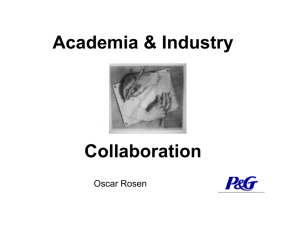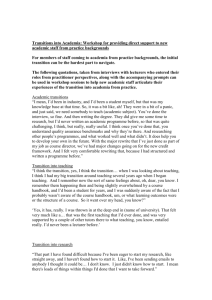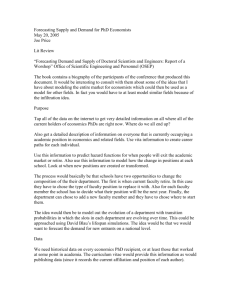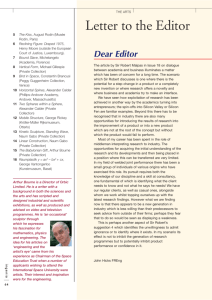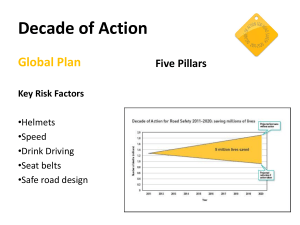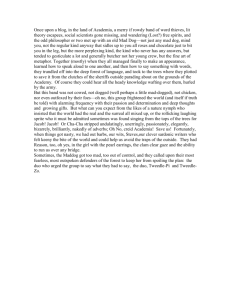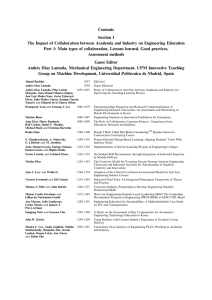Outsourcing/Off-shoring
advertisement
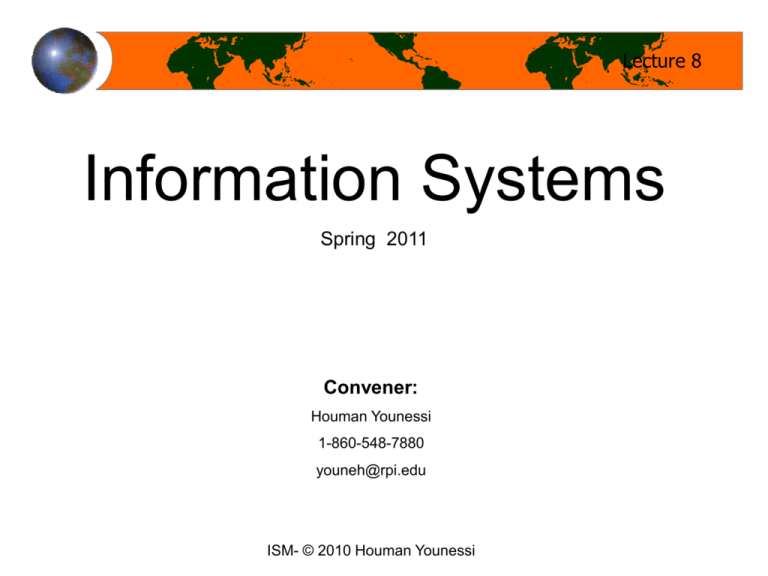
Lecture 8 Information Systems Spring 2011 Convener: Houman Younessi 1-860-548-7880 youneh@rpi.edu ISM- © 2010 Houman Younessi Lecture 8 System Architecture A Rich Picture that: Models the hardware platform wrt the interactions of the system and its environment Models the software components onto the hardware platform Models the major functionality onto software components Lecture 8 ADLs (Architecture Definition Languages): - AADL - ACME - ABACUS - ByADL - C2 - Darwin - DAOP (Industry) (US – Academia) (Australia – Academia) (Italy – Academia) (US – Academia) (UK – Academia) (Spain – Academia) Lecture 8 Architecture Layers: 1. High-level - System within the enterprise environment or functional lines 2. Hardware level - Hardware platforms within the system and their major functionality 3. Software level - Software components mapped to hardware platforms Lecture 8 High-level Architecture: System within the Environment - Enterprise components - System boundary Lecture 8 HW-level Architecture: HW Platforms within the System - Placement of HW - Physical servers - Networking model Lecture 8 SW-level Architecture: SW Components within HW Platform - Middleware - Presentation protocols - Servers Lecture 8 Lecture 8 Lecture 8 Lecture 8 Lecture 8 Lecture 8 Lecture 8 Lecture 8 The Q word Qprod f (Qproc) Lecture 8 We aim to minimize Risk Lecture 8 The main objective of process management is to reduce risk as we go forward in development The quality of a process is therefore measured in terms of its effectiveness in reducing risk. Lecture 8 A value (quality) judgment? Process attributes: Cost Repeatability Measurability etc. Maturity Improvability We must optimize along given – often conflicting - lines Lecture 8 Outsourcing/Off-shoring Logistics culture maturity Organizational proximity Lecture 8 Outsourcing/Off-shoring Short-term effects: Productivity Cost (Financial) Productivity (Organizational) Core competency shift Employment shift Lecture 8 Long-term effects: As it has always happened Lecture 8 Long-term effects: ? Lecture 8 Long-term effects: Lecture 8 Long-term effects: Lecture 8 And on and on it goes Lecture 8 As a manager……… Lecture 8 • How well do you understand the linkages among your strategies, the capabilities and infrastructure built to execute those strategies, and the value that can be created for all stakeholders (e.g., customers, suppliers, partners, employees, investors)? Lecture 8 • Is your business infrastructure best-inclass in terms of asset efficiency and strategic flexibility? How can IT be used to improve your ability to leverage infrastructure and assets to drive profitable growth and create strategic options for the future? Lecture 8 • How well do you understand the key factors that drive business performance in your organization and industry? What must be done well to reduce costs, grow revenues, and improve asset efficiency? How can IT be used to drive profitable growth and achieve proprietary advantage? Lecture 8 • Conduct an audit of your digital business infrastructure. How much are you spending to run and maintain current IT operations? On average, how long does it take and how much does it cost to implement a new IT-enabled business product, service, or strategy? What are key bottlenecks that slow down the ITenabled business innovation process and the key activities that increase the cost? Lecture 8 • Create a list of IT-enabled business strategies and the solutions that could be developed that would leverage an open standard networked infrastructure. Are there opportunities to: • a. Improve internal operating efficiency and quality? • b. Improve knowledge worker performance and enhance organizational learning? c. Increase employee satisfaction, engagement, and loyalty and attract and retain top talent? • d. Increase customer/supplier satisfaction, engagement, and loyalty? • e. Attract and retain high value-added customers, suppliers, and partners? • f. Add "information value" to existing products and services or create new information-based products and services? • g. Streamline and integrate channels to market, create new channels, and integrate multiple online/offline channels? Lecture 8 • From the above list, identify one or more simple, yet powerful, "big wins" where IT could significantly improve business performance. What are the realistic business goals you expect to achieve? Define measurable performance improvements that can be achieved quickly (usually within one year) and the follow-on benefits that will accrue as you pursue strategic options. How will these performance drivers link to financial and capital market performance? Validate your analysis by talking with others who have implemented similar systems. Ask for lessons learned and areas of high risk that must be managed closely. Collect benchmark data on the benefits that can be expected. Lecture 8 • Do you have the resources, expertise, and skills required to successfully complete these projects? Can outside partners be identified when the organization's resources are not sufficient? Lecture 8 • Do you have the political support required to ensure that the project can be completed quickly and effectively? Do project leaders have the resources, authority, and accountability required to get the job done? Lecture 8 • Have you considered ways to limit the scope of the project? Keep in mind the "80/20 rule": you can often achieve 80 percent of the benefit with 20 percent of the effort. Don't push to include hard-toimplement features and functions that are not critical to overall project success. Lecture 8 • Has an effective change control process been implemented? Can you ruthlessly manage "project creep" while not losing sight of the good ideas that emerge during implementation? To assist with the latter task, create two task forces to search for follow-on "options" benefits. One task force can be charged with identifying new IT-enabled business building opportunities to drive profitable growth and build scarce resources and capabilities. The second task force can be charged with searching for ways to continuously enhance infrastructure performance to ensure that the organization achieves and maintains best-in-class status-through partnering or internal development.

